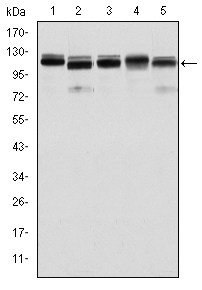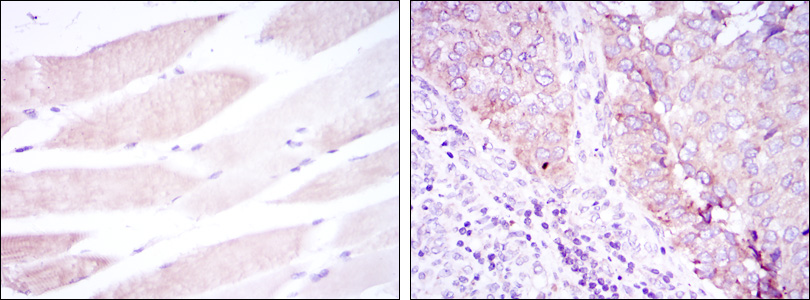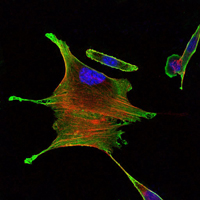BMPR-II Monoclonal Antibody
- 货号:YM0075
- 应用:WB;IHC;IF;ELISA
- 种属:Human;Mouse;Rat;Monkey
- 简介:
- >>Cytokine-cytokine receptor interaction;>>TGF-beta signaling pathway;>>Axon guidance;>>Hippo signaling pathway;>>Signaling pathways regulating pluripotency of stem cells;>>MicroRNAs in cancer;>>Fluid shear stress and atherosclerosis
- 蛋白名称:
- Bone morphogenetic protein receptor type-2
- 免疫原:
- Purified recombinant fragment of human BMPR-II expressed in E. Coli.
- 特异性:
- BMPR-II Monoclonal Antibody detects endogenous levels of BMPR-II protein.
- 组成:
- Liquid in PBS containing 50% glycerol, 0.5% BSA and 0.02% sodium azide.
- 稀释:
- WB 1:500 - 1:2000. IHC 1:200 - 1:1000. IF 1:200 - 1:1000. ELISA: 1:10000. Not yet tested in other applications.
- 纯化工艺:
- Affinity purification
- 储存:
- -15°C to -25°C/1 year(Do not lower than -25°C)
- 其他名称:
- BMPR2;PPH1;Bone morphogenetic protein receptor type-2;BMP type-2 receptor;BMPR-2;Bone morphogenetic protein receptor type II;BMP type II receptor;BMPR-II
- 背景:
- This gene encodes a member of the bone morphogenetic protein (BMP) receptor family of transmembrane serine/threonine kinases. The ligands of this receptor are BMPs, which are members of the TGF-beta superfamily. BMPs are involved in endochondral bone formation and embryogenesis. These proteins transduce their signals through the formation of heteromeric complexes of two different types of serine (threonine) kinase receptors: type I receptors of about 50-55 kD and type II receptors of about 70-80 kD. Type II receptors bind ligands in the absence of type I receptors, but they require their respective type I receptors for signaling, whereas type I receptors require their respective type II receptors for ligand binding. Mutations in this gene have been associated with primary pulmonary hypertension, both familial and fenfluramine-associated, and with pulmonary venoocclusive disea
- 功能:
- catalytic activity:ATP + [receptor-protein] = ADP + [receptor-protein] phosphate.,cofactor:Magnesium or manganese.,disease:Defects in BMPR2 are a cause of pulmonary venoocclusive disease (PVOD) [MIM:265450]. PVOD is a rare form of pulmonary hypertension in which the vascular changes originate in the small pulmonary veins and venules. The pathogenesis is unknown and any link with PPH1 has been speculative. The finding of PVOD associated with a BMPR2 mutation reveals a possible pathogenetic connection with PPH1.,disease:Defects in BMPR2 are the cause of primary pulmonary hypertension (PPH1) [MIM:178600]. PPH1 is a rare autosomal dominant disorder characterized by plexiform lesions of proliferating endothelial cells in pulmonary arterioles. The lesions lead to elevated pulmonary arterial pression, right ventricular failure, and death. The disease can occur from infancy throughout life and i
- 细胞定位:
- Cell membrane ; Single-pass type I membrane protein.
- 组织表达:
- Highly expressed in heart and liver.

- Western Blot analysis using BMPR-II Monoclonal Antibody against HeLa (1), A431 (2), NIH/3T3 (3), Cos7 (4) and PC-12 (5) cell lysate.

- Immunohistochemistry analysis of paraffin-embedded muscle tissues (left) and kidney cancer tissues (right) with DAB staining using BMPR-II Monoclonal Antibody.

- Immunofluorescence analysis of Eca109 cells using BMPR-II Monoclonal Antibody (green). Blue: DRAQ5 fluorescent DNA dye. Red: Actin filaments have been labeled with Alexa Fluor-555 phalloidin.







